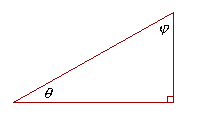Similar figures
PLANE TRIGONOMETRY is based on the fact of similar figures. (Topic 1: Ratio and proportion.) We saw:
Figures are similar if they are equiangular
and the sides that make the equal angles
are proportional.
For triangles to be similar, however, it is sufficient that they be equiangular. (Theorem 15 of "Some Theorems of Plane Geometry.") From that it follows:
Right triangles will be similar if an acute angle of one
is equal to an acute angle of the other.

In the right triangles ABC, DEF, if the acute angle at B is equal to the acute angle at E, then those triangles will be similar. Therefore the sides that make the equal angles will be proportional. If CA is half of AB, for example, then FD will also be half of DE.
Now a trigonometric Table is a table of ratios of sides. In the Table, each value of sin θ represents the ratio of the opposite side to the hypotenuse -- in every right triangle with that acute angle.
If angle θ is 28°, say, then in every right triangle with a 28° angle, its sides will be in the same ratio. We read in the Table,
sin 28° = .469
This means that in a right triangle having an acute angle of 28°, its opposite side is 469 thousandths of the hypotenuse, which is to say, a little less than half.
It is in this sense that in a right triangle, the trigonometric ratios -- the sine, the cosine, and so on -- are "functions" of the acute angle. They depend only on the acute angle.
Example. Indirect measurement. Trigonometry is used typically to measure things that we cannot measure directly.

For example, to measure the height h of a flagpole, we could measure a distance of, say, 100 feet from its base. From that point P, we could then measure the angle required to sight the top . If that angle (called the angle of elevation) turned out to be 37°, then
To see the answer, pass your mouse over the colored area.
To cover the answer again, click "Refresh" ("Reload").
Complements
Two angles are called complements of one another if together they equal a right angle. Thus the complement of 60° is 30°. This is the degree system of measurement in which a full circle, made up of four right angles at the center, is called 360°. (But see Topic 14: Radian Measure.)
Problem 3. Name the complement of each angle.
a) 70°
20°
b) 20°
70°
c) 45°
45°
d) θ
90° − θ

The point about complements is that, in a right triangle, the two acute angles are complementary. For, the three angles of the right triangle are together equal to two right angles (Theorem 9); therefore, the two acute angles together will equal one right angle.
Cofunctions
There are three pairs of cofunctions:
The sine and the cosine
The secant and the cosecant
The tangent and the cotangent
And here is the significance of a cofunction:
A function of any angle is equal to the cofunction
of its complement.
This means that sin 80°, for example, will equal cos 10°.
The cosine is the cofunction of the sine. And 10° is the complement of 80°.
Problem 4. Answer in terms of cofunctions.
a) cos 5° = sin
85°
b) tan 60° =
cot 30°
c) csc 12° = sec 78°
d) sin (90° − θ) = cos θ
e) cot θ = tan (90° − θ)

In the figure: